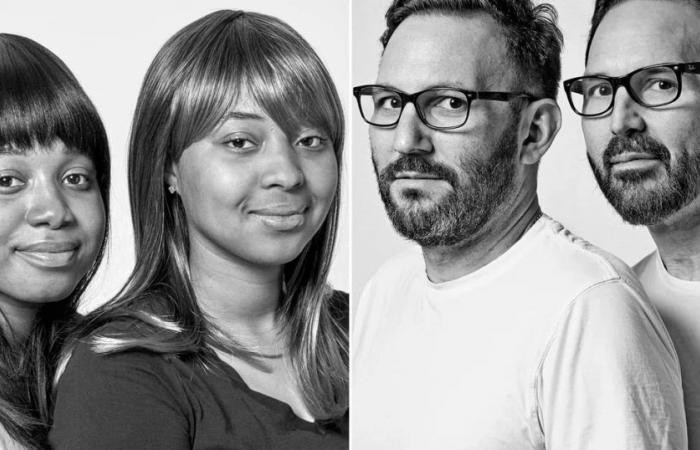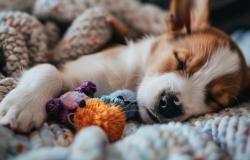Does each person have their double in the world? François Brunelle, A Canadian photographer based in Montreal has been seeking to answer this question since 1999, the year in which he began traveling to different countries with the aim of finding people who were unknown to each other, but who were physically identical.
It was no surprise for him to start finding these “doubles”, since he himself was always compared to the actor who plays Mr. Bean and, in addition, he experienced the meeting with one of his peers in a restaurant in Prague while sharing a dinner with friends and wanted to know if other people also had their double. Thus he began the path of one of the most amazing projects that have been carried out in recent years: not only did he find them but he began a photographic documentation of those similarities and the result is shared in the project I’m Not a Look-Alike, started at the end of the last century. Almost 25 years after creating it, she brings together a collection of black and white portraits of approximately 250 couples in 32 cities around the world.
This idea of the exact double does not belong to the photographer. A study carried out by the researcher Teghan Lucas, who sought to put a halo of science on urban belief, concluded that we all have an exact double of us somewhere of the world.
“There are genes involved in the size and shape of the face, others in eye color, others in hair… And the fact that there are many more cells that determine what our facial appearance will be like than those that influence, for example, For example, in what the hand or legs will be like, it is proof that our species tends toward diversity,” he says in his study.
“Although there are many, that amount that is involved in our physical appearance is limited. This means that although there are many possible combinations, in the end as the population increases, it reaches the point where some end up repeating themselves,” says Lucas, who explains that This probability increases the more similar the genes are. of two people: “That’s why our relatives are more like us than other people. And it will always be easier to find physical similarities between two people of Asian origin than between a Korean and a Norwegian.”
Researchers of the Josep Carreras Leukemia Research Institute of Barcelona revealed in the article Similar humans identified by facial recognition algorithms show genetic similaritiespublished in the magazine Cell Reports that The strong facial resemblance is associated with shared genetic variants.
“The human face is one of the most visible features of our unique identity as individuals. Interestingly, monozygotic twins share almost identical facial features and the same DNA sequence, but could present differences in other biometric parameters. The expansion of the world wide web and the ability to exchange photographs of humans across the planet has increased the number of people identified online as unrelated twins or virtual doubles. Here, we have characterized in detail a set of “similar” humans, defined by facial recognition algorithms, by their multi-omic landscape. We report that these individuals share similar genotypes and differ in their DNA methylation and microbiome landscape. These results not only provide information about the genetics that determine our face, but could also have implications for the establishment of other human anthropometric properties and even personality characteristics,” the study summarizes.
Brunelle’s more than 200 pieces testify to the strange phenomenon that is being investigated by science: why do people who are not related share such similar DNA and physical traits? This is what refers to Doppelgänger theory whose German term defines the “ghostly double or evil shadow of a living person.” This is how the novelist Jean Paul gave it meaning in 1796, when he defined Doppeltgänger as “he who walks next to you.”
Since then, that word has been used to designate the “double of a person”, but meaning that other person as the “evil twin”. Thus, the Doppelgänger They were protagonists of literary works of science fiction and fantasy literature.
“I am fascinated by finding doubles in people,” admitted photographer Francois Brunelle to the British portal Daily Mail and said that since he was 18 he has been studying human faces. “The fact that two people with no relation to each other and sometimes born in different countries share the same physical appearance,” he said, the axis of his already recognized work that began in the United States, but which took him around the world, managing to become in an acclaimed international exhibition and in a book.
According to him, his objective is explore the relationship that can generate the meeting of two people who do not know each other and who upon seeing each other discover that they are identical. To expand these possibilities, he asked that people who know that they have their double write to him so that he can portray them.
The photographs he takes of them are focused on the lighting and the angle of the people. It is precisely the black and white of the strange portraits that highlights the facial features. At the same time, he uses that technique to show that they are not exact doubles.
“A very perfect couple of similarities would be boring,” he says and says that by making them pose so close it helps to identify each of the people’s similarities and also the differences they have. “Similarities are not equal. They look alike, not much more, but that’s what fascinates me. May someone, in this world, look in the mirror and see more or less the same thing that I see in different mirrors.”
It all started when Brunelle was working as an advertising photographer. He often wore short hair and was compared to the English actor Rowan Atkinson, known for his role as Mr. Bean. Paradoxically, despite a letter he wrote to the actor and a visit to London to get a photo with him, he did not succeed.
Despite feeling disappointed, he continued his search and found that he has two doubles in Canada. This phenomenon also has a statistical explanation: there are more than 7,000 million human beings and there are a limited number of genetic combinations; by chance, two people can have the same traits without being related.
Despite that, for the photographer, it is more of an almost philosophical question: “I wonder if anyone else sees the same thing as me when I stand in front of the mirror every morning.”
When he knew where he was going with his idea, François did not want to look for those who look like celebrities but rather “ordinary people” who are similar to each other. By making his idea public, he began to receive help from friends and family, from local Montreal media who spread his proposal. He was disappointed after the first five years: he found only about twenty similar people.
But not only did he continue with his goal, but he also created a page where he showed them and which currently contains updated images of the pairs of different nationalities, races, ages and gender. With this proposal, Brunelle reached the United States, France, Germany, Switzerland, Italy, the United Kingdom and in 2014 Colombia, which became its first Latin American destination.
In Bogotá he spoke to the local press and said: “We found very good couples and in some cases, exceptional ones.” The results will be revealed in a traveling exhibition and a documentary that will be seen between July and August of this year.
“Meeting your double can change your life,” says Brunelle. I remember, for example, two bald men who came to the studio, greeted each other, started talking and suddenly one asked the other: ‘Well, are you married?’ And the other tells him: ‘Yes, my wife’s name is Francine.’ And the first one answers: ‘Mine too!’. From that day on, the four of them became very good friends.”
For the Canadian, these coincidences, which go beyond the physical, justify all the effort. “I am an artist and I don’t know scientifically why this happens. I have a large collection of doubles, but I want more and more. It is an inexplicable fascination,” he says.
Explaining his work, he says that all photographs of the Montreal area are taken in his studio and when he is in other cities he rents local studios. “The photographs are very simple, the taking process is quite simple. The models stand side by side on a neutral background and improvise poses. The interaction is natural and relaxed. The session lasts between one or two hours,” he says and explains that the photographs are in black and white because “in general, the clarity and simplicity of black and white photographs eliminate superfluous elements, such as skin color and color. hair, and allow us to focus more on the essential similarities in facial structure between the two doubles”.






